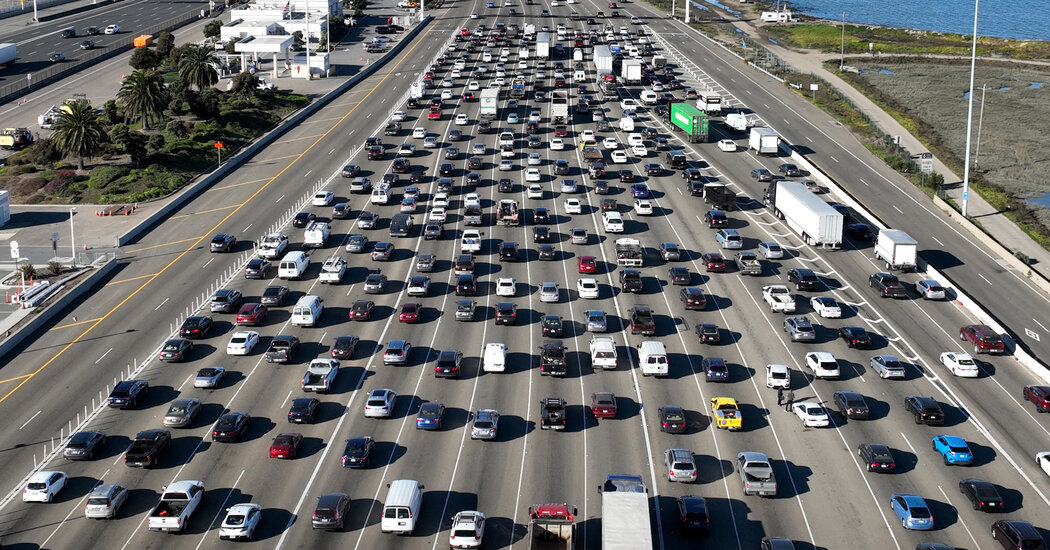
California regulators on Thursday will vote to put in place a sweeping plan to restrict and ultimately ban the sale of gasoline-powered cars, state officials said, a move that the state’s governor described as the beginning of the end for the internal combustion engine.
The new policy, detailed Wednesday morning in a news conference, is widely expected to accelerate the global transition toward electric vehicles. Not only is California the largest auto market in the United States, but more than a dozen other states typically follow California’s lead when setting their own auto emissions standards.
If those states follow through, and most are expected to adopt similar rules, the restrictions would apply to about a third of the United States auto market.
“This is huge,” said Margo Oge, an electric vehicles expert who headed the Environmental Protection Agency’s transportation emissions program under Presidents Bill Clinton, George W. Bush and Barack Obama. As additional states put in place their own versions of these policies, “they will drive the market, and drive innovation,” she said.
The rule, issued by the California Air Resources Board, will require that all new cars sold in the state by 2035 be free of greenhouse gas emissions like carbon dioxide. The rule also sets interim targets, requiring that 35 percent of new passenger vehicles sold by 2026 produce zero emissions. That requirement climbs to 68 percent by 2030.
Transportation is the nation’s top source of planet-warming greenhouse-gas emissions.
Gavin Newsom, the governor of California, called the new rule “one of the most significant steps to the elimination of the tailpipe as we know it.”
“Our kids are going to act like it’s a rotary phone, or changing the channel on a television,” Governor Newsom said in an interview.
John Bozzella, president of the Alliance for Automotive Innovation, which represents large U.S. and foreign automakers, said that automakers wanted to see more electric vehicles on the roads, but that California’s mandates would be “extremely challenging” to meet.
“Whether or not these requirements are realistic or achievable is directly linked to external factors like inflation, charging and fuel infrastructure, supply chains, labor, critical mineral availability and pricing, and the ongoing semiconductor shortage,” Mr. Bozzella said by email.
Read More on the Newsom Administration
President Trump had fought California’s authority under the Clean Air Act to set its own rules regulating automobile pollution, and there remains the possibility that a future president might fight full implementation of the new rules. In addition, a group of attorneys general from Republican states have filed a lawsuit challenging California’s ability to set its own pollution rules.
Critics of policies that encourage the rapid adoption of electric vehicles point out that sticker prices for electrics are still much higher than for similar gasoline powered cars. And Ann Bluntzer, the executive director of the Ralph Lowe Energy Institute at Texas Christian University, said in a statement that the conversion to electric vehicles could put a strain on electricity grids.
“Where is that increased power being sourced from?” Ms. Bluntzer said. “Fossil fuels? Wind? Solar? Hydro?”
California’s ban comes as gasoline prices continue to fall, this week dropping to a national average of $3.90 a gallon. Still, Mr. Newsom said, the fact that prices shot up after Russia’s invasion of Ukraine underscored the urgency to “transition away from petro-dictators and dependency on the oil markets.”
The new policy in California follows an expansive new climate law signed by President Biden last week. The law will invest $370 billion in spending and tax credits on clean energy programs, the largest action taken by the federal government to combat climate change. The legislation is projected to help the United States cut its emissions 40 percent below 2005 levels by the end of this decade.
Still, that law alone won’t be enough to eliminate U.S. emissions by 2050, the target that climate scientists say nations must reach if the world is to avoid the most catastrophic and deadly effects of climate change.
To help close the gap, White House officials have vowed additional policies, such as new regulations on tailpipe emissions, but they have also said that individual states must take further action.
Experts said the new California rule, given its potential reach, could stand alongside the law signed by Mr. Biden last week as one of the world’s most important climate change policies.
In California, the new rule will cut greenhouse gas emissions from passenger vehicles by more than 50 percent in 2040 from the levels that were expected without the policy, according to state regulators. That amounts to eliminating 395 million metric tons of greenhouse gas emissions over that time period, or the equivalent of burning 915 million barrels of oil, said Liane Randolph, chairwoman of the California Air Resources Board.
That effect could potentially also spread to 16 other states, big and small. That’s because those states have traditionally followed California’s lead.
California will now send its final rule to the Environmental Protection Agency to request the waiver, which the Biden administration has signaled that it is likely to grant. A spokesman for the agency didn’t respond to a request for comment.
Because of the way the waiver works, California must first get approval from the E.P.A. for its own rules before other states can enforce similar restrictions, Ms. Oge said. A few states — including New York, Washington and Massachusetts — already had similar legislation in the works, and many of the other states that follow California’s lead are expected to consider similar rules over the next year or so.
The governments of Canada, Britain and at least nine other European countries — including France, Spain and Denmark — have set goals of phasing out the sale of new gasoline-powered vehicles between 2030 and 2040. But none have concrete mandates or regulations like the California rule.
“This regulation will set the global high-water mark for the accelerated transition to electric vehicles,” said Drew Kodjak, executive director of the International Council on Clean Transportation, a research organization.
In Washington, Mr. Biden last year signed an executive order calling for the government to try to ensure that half of all vehicles sold in the United States be electric by 2030, up from 6 percent today, although the order has no binding legal force.
Mr. Biden has also sought to enact federal policies that would further scale up the nation’s use of electric vehicles. The recent climate bill includes $7,500 in rebates for people who purchase new electric vehicles, although automakers will have to assemble their vehicles in North America and source their batteries from friendly countries to qualify for the full credit. California officials said that provision would combine with $10 billion in a state program to make automobiles more affordable and build charging stations and other electric-vehicle infrastructure, particularly in low-income communities.
Several automakers said their strategies were aligned with California’s goal of promoting emission-free vehicles.
General Motors said it was still reviewing the rule but that the company also had a goal of selling only electric vehicles by 2035. “General Motors and California have a shared vision of an all-electric future,” said Elizabeth Winter, a spokeswoman for G.M.
Ford’s chief sustainability officer, Bob Holycross, said the company planned to invest more than $50 billion in electric vehicles and batteries by 2026 and said the rule would “set an example for the United States.” A spokesman for Stellantis, which owns Chrysler, Fiat, Dodge and other brands, said the company intended to introduce 25 new electric models by 2030 to help support California’s goals.
In a statement, Honda called California’s rule “an ambitious but important milestone” but cautioned that reaching the goal would require several steps, including building out domestic supply chains so that more vehicles could qualify for the federal tax credit.
Toyota, one of the world’s largest automakers, didn’t comment on California’s new rule but this week said in a statement that it acknowledged California’s “leadership in climate policies and its authority to set vehicle emissions standards under the Clean Air Act.” During the Trump administration, Toyota had sued to block California from setting stricter rules than the federal government.
To enforce its rule, Ms. Randolph said California would fine automakers up to $20,000 for every car that falls short of production targets. The state also could propose new amendments revising the sales targets if the market doesn’t react as state leaders hope, said Jennifer Gress, who leads the California air board’s sustainable transportation division.
State officials say about 16 percent of cars sold in California today are electric, up from 12.4 percent last year.
“We recognize that not everyone is going to be buying a very expensive, brand-new car,” Ms. Randolph said. “But we also know that prices will go down in the future.”
Last year, the Environmental Protection Agency restored and slightly strengthened an Obama-era fuel economy rule that had been set aside by the Trump administration. It requires passenger vehicles to get 55 miles per gallon by 2026, from just under 40 miles per gallon today.
That national regulation is much less ambitious than California’s new rule, but it was the Biden administration that allowed California to press forward with its ambitious policy: It restored California’s waiver under the Clean Air Act, which former President Donald J. Trump had halted.
The waiver dates from 1970, when Los Angeles was choking with smog and Congress was enacting the landmark Clean Air Act. California was allowed to set tougher emissions standards than the federal government, but had to provide a compelling reason to be granted a waiver. In 1977, other states were allowed to adopt California’s stricter standards.
The Biden administration’s reinstatement of the waiver is what enabled California to move forward with its new rule this week. Once in place, California’s regulations are expected to influence a new federal standard that the E.P.A. expects to introduce next year, further encouraging automakers to build and sell more electric vehicles.
There is already fierce legal pushback against those plans.
The attorneys general of 17 Republican-led states have sued to revoke the California waiver, which would undo the state’s new policy. Patrick Morrisey, the attorney general of West Virginia and one of the plaintiffs in the lawsuit, called California’s waiver “favoritism” that “violates the states’ equal sovereignty.”
The lawsuit, which will be heard before the United States Court of Appeals for the District of Columbia Circuit, considered the nation’s second most powerful bench after the Supreme Court. Oral arguments have not yet been scheduled.




